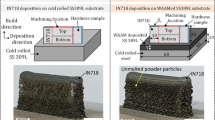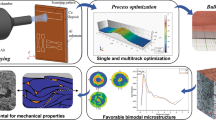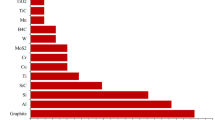Abstract
To increase the performance of discharge ablation, a sintered diamond (SD) electrode is used as a machining electrode to achieve machining combined with high-efficiency ablation and mechanical grinding in this paper. A new constant pressure servo control method based on the SD electrode is proposed by gathering the mechanical grinding force during machining. Using Cr12 as the workpiece, we conducted five groups of comparative experiments in this study. They are mechanical grinding with SD electrode, inner jetted dielectric electrical discharge machining (EDM) with copper electrode, aerosol ablation with copper electrode, aerosol ablation based on voltage control with SD electrode, and aerosol ablation based on constant pressure with SD electrode. In this paper, we studied the mechanism, machining efficiency, and machining quality. The method based on constant pressure servo control with SD electrode can effectively grind the oxide layer and ensure the sustainability of machining. From these five groups of experiments, we concluded that the method based on constant pressure servo control can be efficient and stable during machining. The machining efficiency was 6.3 times that of the inner jetted dielectric EDM. The machining efficiency based on constant pressure servo control increased by 88% compared with that of the aerosol ablation with copper electrode and it increased by 62% compared with that of the aerosol ablation based on voltage with SD electrode which showed that the grinding effect of diamond based on constant pressure servo control was obvious. Compared with the other four methods, the method based on constant pressure servo control can obtain the best surface quality.
Similar content being viewed by others
References
Liu ZD (2013) Nontraditional machining. Peking University Press, Beijing
Kunieda M, Yoshida M, Taniguchi N (1997) Electrical discharge machining in gas. CIRPAnn Manuf Technol 46(1):143–146
Li LQ, Wang ZL, Zhao WS (2004) Mechanism analysis of electrical discharge machining in gas. J Harbin Inst Technol 36(3):359–362
Tanimura T, Isuzugawa K, Fujita I, Iwamoto A, Kamitani T (1989) Development of EDM in the mist. Proc ISEM 9:313–316
Wang XZ, Liu ZD, Xue RY, Tian ZJ, Huang YH (2013) Research on self-mixed oxygen in discharge gap to improve the processing characteristics of titanium alloy electrical discharge machining. Acta Aeronaut Astronaut Sin 34:2419–2426
Liu ZD (2012) Typical process for high efficiency machining of discharge induced controlled ablation. Electromachining Mould 1:1–6
Wang XZ, Liu ZD, Qiu MB, Hui ZG, Tian ZJ, Huang YH (2014) Mechanism of electrical discharge machining ablation. Mater Manuf Process 29(11–12):1367–1373
Qiu MB, Ling JJ, Chen LH, Liu ZD (2015) Mechanism of discharge ablation machining of diamond sintered electrode. J Mech Eng 03:190–195
Fujiki M, Kim GY, Ni J (2011) Gap control for near-dry EDM milling with lead angle. Int J Mach Tools Manuf 51(1):77–83
Fonseca J, Marafona J (2013) The importance of servo reference voltage on multiple discharges. Procedia CIRP 6:416–421
Wu J, Zhou M, Xu X, Yang J, Zeng X, Xu D (2016) Fast and stable electrical discharge machining. Mech Syst Signal Process 72:420–431
Hsieh M, Tung C, Yao WS (2007) Servo design of a vertical axis drive using dual linear motors for high speed electric discharge machining. Int J Mach Tools Manuf 47(3):546–554
An QL (2006) The application of cryogenic pneumatic mist jet impinging in mechanical machining of titanium alloy. University of Aeronautics and Astromantics
Cao ZL, Liu ZD, Ling JJ, Qiu MB, Wang XZ (2015) Deep-type hole machining by inner jetted aerosol dielectric ablation. Int J Adv Manuf Technol 78(9–12):1989–1998
Zhao WS (2003) Advanced electrical discharge machining technology. National Defence Industry Press, Beijing
Author information
Authors and Affiliations
Corresponding author
Rights and permissions
About this article
Cite this article
Jingyun, S., Mingbo, Q., Lida, S. et al. Discharge ablation grinding machining based on constantpressure feeding. Int J Adv Manuf Technol 91, 257–264 (2017). https://doi.org/10.1007/s00170-016-9714-x
Received:
Accepted:
Published:
Issue Date:
DOI: https://doi.org/10.1007/s00170-016-9714-x




